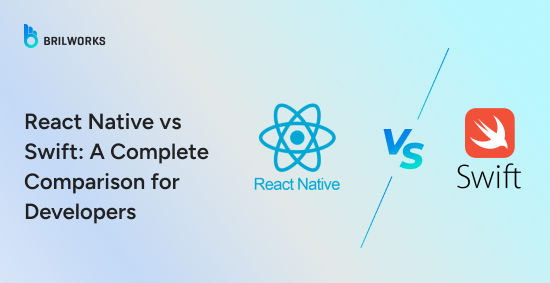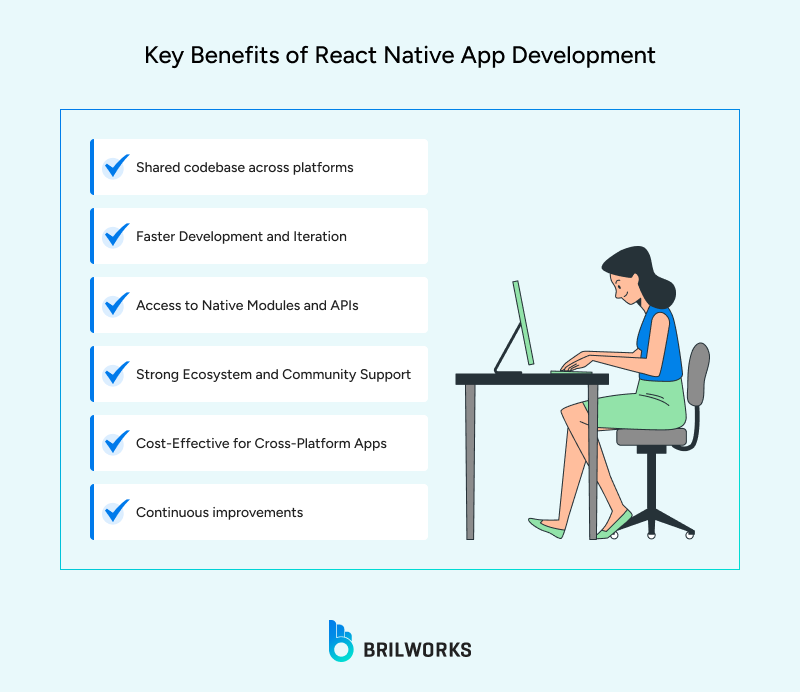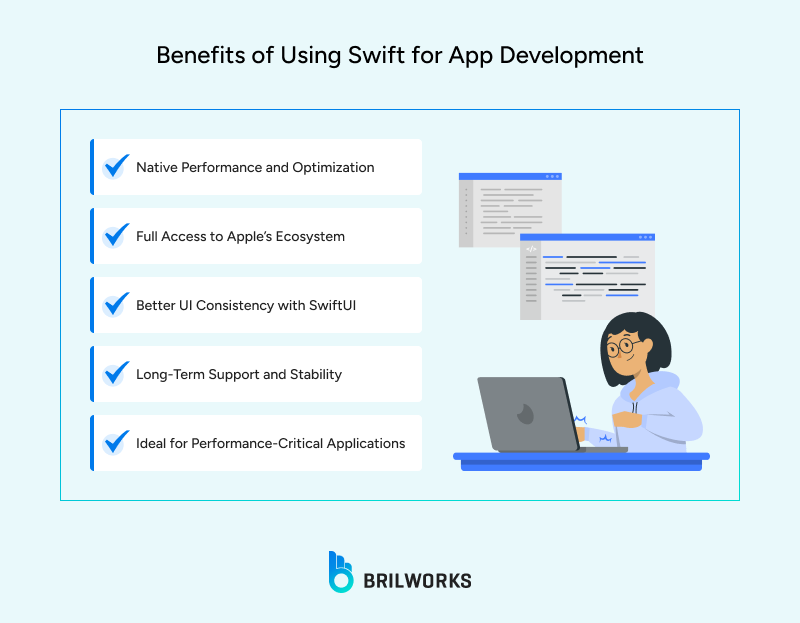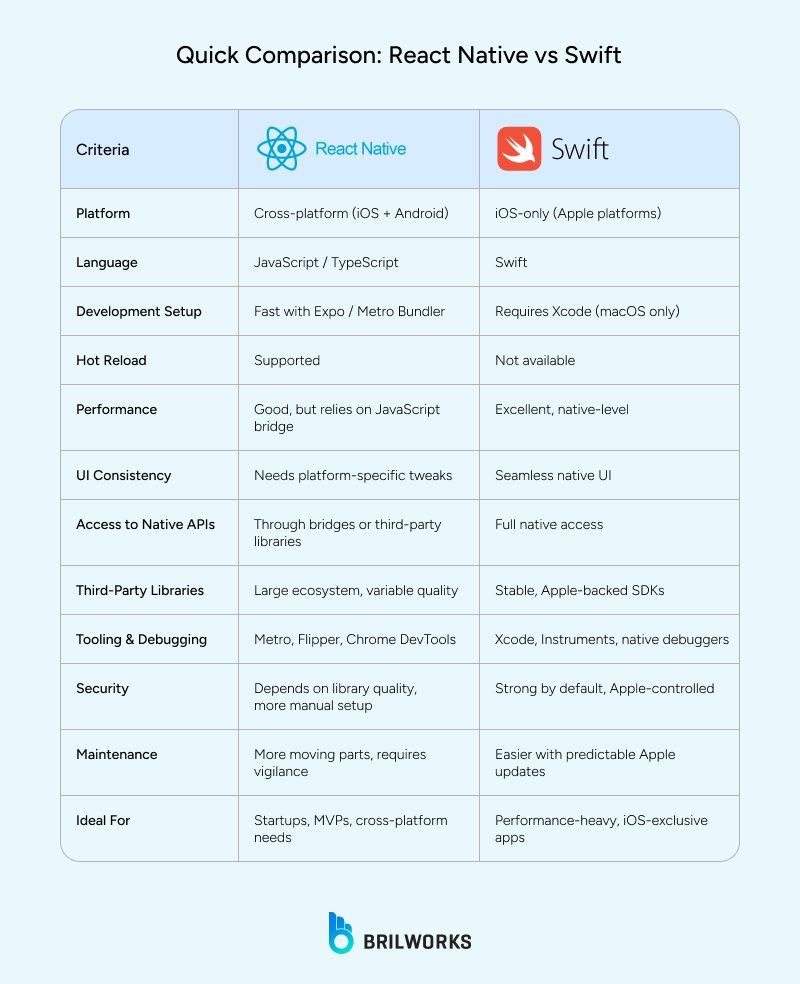COOPERATION MODEL
ARTIFICIAL INTELLIGENCE
PRODUCT ENGINEERING
DevOps & Cloud
LOW-CODE/NO-CODE DEVELOPMENT
INDUSTRY
FRONTEND DEVELOPMENT
CLOUD DEVELOPMENT
MOBILE APP DEVELOPMENT
LOW CODE/ NO CODE DEVELOPMENT
EMERGING TECHNOLOGIES








Apple's WWDC events often serve as a major catalyst for new trends and technologies. While the hypothetical "liquid glass" announced at WWDC 2025 might be a futuristic vision, it perfectly encapsulates the rapid pace of innovation that keeps iOS app development a meticulous process.
With updates and new features rolling out consistently, choosing the right framework becomes important. There are two ways you can do this: 1. Embrace the native power of Swift for app development, 2. Opt for React Native to reach both iOS and Android users with a single codebase.
The short answer is to choose Swift development if you are really opting for iOS only. Swift development is smooth, but it has a deep learning curve. Choose React Native app development if your app has a simple UI and you need simple code logic.
So, which should you choose: React Native vs Swift? Or should you also be thinking in terms of React Native vs SwiftUI, given Apple’s growing focus on declarative UI?
In this blog, we will answer the much-talked-about comparison between React Native and Swift, their pros, cons, tradeoffs, and use cases of both approaches.

React Native is a popular open-source framework developed by Meta that allows developers to build mobile applications using JavaScript and React. So, if you are going to build with React Native, remember to know the difference between React and React Native.
React Native is the face of JavaScript for developing cross-platform apps. It allows you to build native-like apps for both iOS and Android using a single codebase. This makes React Native appealing for startups and cross-functional teams for faster development cycles and reduced overhead.
At its core, React Native bridges the gap between web development and native app performance. Instead of rendering web views, It uses native components under the hood, giving users the feel of a native app while developers enjoy the flexibility of a web-like workflow.
React Native is widely known for its cross-platform ability. It possesses a massive community, and there is a vast ocean of third-party libraries that allow developers to make cross-platform app that runs on both Android and iOS.
With features like Hot Reloading and tools like Expo, developers can see changes in real time without rebuilding the entire app. This significantly speeds up the development cycle, especially during prototyping or debugging.
React Native offers a bridge that enables communication between JavaScript and native code. This means you can access device features like the camera, GPS, or Bluetooth through native modules, and even write custom Swift or Java modules if needed.
As we mentioned, React Native has massive community support. Whether you are implementing navigation, animations, or authentication, chances are there's a well-maintained package already available.
Because you are building one app instead of two, React Native app development can cut costs without compromising too much on user experience, especially for content-driven or moderately interactive applications.
As a well-known JavaScript framework and a large community, React Native never falls behind. Tools like the Hermes JavaScript engine and Fabric rendering system have made apps faster and more memory-efficient, further closing the performance gap with fully native solutions.
Some of the most widely used apps today leverage React Native under the hood. For example:
Pintrest
Discord
Bloomberge
Uber Eats
WalMart

Swift is a primary programming language that supports the entire Apple ecosystem, including iOS, iPadOS, macOS, watchOS, and tvOS. It was first introduced in 2014 as a modern replacement for Objective-C. Swift became known for its clean syntax, performance, and deep integration with Apple's platforms.
When it comes to iOS app development, hardly anyone can beat Swift as the preferred choice for developers who want full access to Apple's latest APIs, hardware capabilities, and system-level features. There's also SwiftUI, a popular tool for creating seamless UI for iOS apps. SwiftUI also gets compared to React Native often, as both promise a native like experience.
Unlike cross-platform frameworks, Swift lets you create truly native apps that are not only native in performance but in design patterns and accessibility as well.
Because Swift compiles directly to machine code and is tightly integrated with Apple's SDKs, apps built with Swift typically offer faster launch times, smoother animations, and better memory management than cross-platform alternatives.
Swift gives developers immediate access to new APIs and features introduced at events, whether it's Apple Vision Pro integration or the latest security frameworks.
Apple continuously invests in SwiftUI, which allows developers to build UI more efficiently using a declarative syntax. SwiftUI also enables smoother animations, adaptive layouts, and better support for accessibility.
Apple's commitment to Swift ensures that the language will remain a core part of its ecosystem for years to come. The means stable updates, robust documentation, and first-class support across Xcode and Apple's entire toolchain.
With cross-platform frameworks, you might face an issue with performance, but not with native frameworks. Native frameworks like Swift are built for tasks where performance and low-level system access are non-negotiable.
Most of Apple's native apps, like Safari, Mail, and Maps, are written in Swift. In the wider ecosystem, other apps include:
WordPress
Airbnb
Slack
Coursera
Lyft

The main difference between React Native and Swift is that Swift is a primary choice if you are building an app, particularly for iOS, and choose React Native if you are looking for cross-platform development.
Let's dive deeper into the comparison and help you decide which one is the right choice for your iOS app development.
React Native is easier to set up, especially with tools like Expo. It uses JavaScript and a component-based structure that's familiar to web developers. Hot reload makes UI development fast and efficient. However, debugging native modules can be tricky, and performance testing requires extra tools.
Swift development runs through Xcode, which is macOS-only but deeply integrated. The language is type-safe and clean, with SwiftUI offering a modern, declarative approach. Build times can be longer, but native debugging and testing tools are robust and reliable.
React Native performs well for most use cases, but it relies on a JavaScript bridge to communicate with native modules, which can introduce latency in animations or heavy computations. While improvements like the Hermes engine and Fabric renderer have reduced overhead, it's still not ideal for performance-critical apps. Accessing device features like the camera or sensors often requires third-party libraries or custom native modules.
Swift delivers top-tier performance with direct access to iOS APIs and hardware. There's no bridging layer, so animations, gestures, and real-time processing run smoothly. It's the better choice when low-level performance, fast load times, or advanced native features are essential.
React Native benefits from a massive open-source community and a wide range of third-party libraries, especially for cross-platform features like navigation, authentication, and UI components. Tools like React Navigation and Firebase integrations are well-maintained. However, the quality of libraries can vary, and some may lack native-level polish or require linking native code for full functionality.
Swift has strong, stable support through Apple's SDKs and frameworks. Libraries are generally more consistent and better integrated with iOS updates. The ecosystem around SwiftUI is growing, but it's still maturing compared to UIKit. Since Apple controls the tooling, compatibility and maintenance are more predictable, especially for long-term iOS projects.
React Native follows a "write once, run anywhere' approach. It enables shared codebases for iOS and Android, which saves development time and cost. However, you may still need platform-specific tweaks to maintain a native-like user experience. Design inconsistencies or edge case bugs across platforms are common trade-offs.
Swift is Apple's native language, purpose-built for iOS. It's tightly aligned with Apple's design patterns, performance expectations, and ecosystem updates. This leads to more consistent behavior and seamless integration, but you will need a separate codebase if you plan to launch on Android too.
Also read: Native vs Cross-platform development
React Native apps depend on third-party libraries for many critical features, which can introduce vulnerabilities if those packages aren't actively maintained. While React Native itself gets regular updates, breaking changes or plugin incompatibilities can increase maintenance overhead. Security best practices must be enforced manually, especially when handling sensitive data across platforms.
Swift gives you full control over the app’s code and access to Apple’s secure APIs. With fewer external dependencies and native SDKs that align with iOS updates, Swift apps are generally easier to secure and maintain long-term. Plus, Apple’s strict app review process encourages adherence to secure coding standards from the start.
Your ideal pick for iOS app development depends heavily on what type of app you are making, what your budget and timeline are. Here's a practical breakdown to help guide your decision:
React Native is a smart choice when:
You’re building an MVP or prototype that needs to run on both iOS and Android quickly.
You have a tight budget or a small team and want to minimize development effort.
Your app doesn’t require extremely complex animations or native performance.
You already have web developers familiar with JavaScript or React.
Thanks to the growing ecosystem around react native app development, it’s easier than ever to tap into reusable components, build fast, and scale later.
Go with Swift when:
You're developing an iOS-exclusive app that needs to be polished, performant, and optimized for Apple devices.
The app requires deep integration with native APIs like ARKit, CoreML, or Metal.
Security, performance, and platform consistency are critical from day one.
You want long-term alignment with Apple’s evolving UI frameworks like SwiftUI.
If your app is performance-intensive — such as a high-end game, a media editing tool, or one involving real-time hardware control — Swift for app development remains unmatched.
Ultimately, the debate between React Native and Swift for iOS mobile app development boils down to a fundamental choice: cross-platform development vs native development. Both are robust technologies fully capable of building feature-rich iOS applications.
Opt for React Native if your primary goal is to develop an app that runs seamlessly on both iOS and Android with a single codebase. This approach can significantly reduce development time and cost, making it ideal for projects where broad platform reach is a priority.
Conversely, choose Swift when your app demands the highest level of performance, direct access to all of Apple's native APIs, or when it requires a deeply integrated and highly optimized user experience specific to the iOS ecosystem. This is often the preferred route for complex applications, high-performance games, or apps that heavily utilize cutting-edge iOS features.
So, for your next iOS app, which path will you take?
React Native is a cross-platform framework for building apps using JavaScript, while Swift is Apple’s native programming language for iOS app development.
It depends on your goals. React Native is ideal for cross-platform apps and faster development, while Swift offers better performance and full access to iOS features.
Choose Swift when performance, native iOS UI, or deep hardware integration (like ARKit, sensors) is critical for your app.
Yes, you can integrate Swift modules into a React Native app to handle platform-specific features or optimize performance-critical components.
Swift generally delivers faster runtime performance, while React Native offers faster development cycles with hot reloading and shared code.
React Native powers apps like Instagram, Discord, and Shopify. Swift is used by Apple and many iOS-exclusive apps requiring top-tier performance.
Get In Touch
Contact us for your software development requirements
Get In Touch
Contact us for your software development requirements